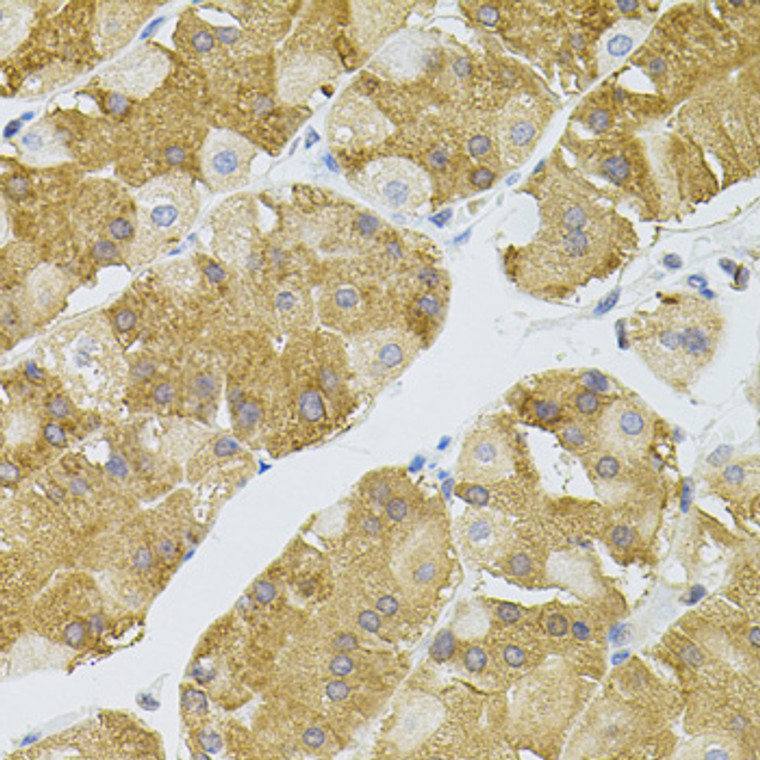| Host: |
Rabbit |
| Applications: |
WB/IHC |
| Reactivity: |
Human/Mouse/Rat |
| Note: |
STRICTLY FOR FURTHER SCIENTIFIC RESEARCH USE ONLY (RUO). MUST NOT TO BE USED IN DIAGNOSTIC OR THERAPEUTIC APPLICATIONS. |
| Short Description: |
Rabbit polyclonal antibody anti-NAT8 (61-220) is suitable for use in Western Blot and Immunohistochemistry research applications. |
| Clonality: |
Polyclonal |
| Conjugation: |
Unconjugated |
| Isotype: |
IgG |
| Formulation: |
PBS with 0.02% Sodium Azide, 50% Glycerol, pH7.3. |
| Purification: |
Affinity purification |
| Dilution Range: |
WB 1:500-1:2000IHC-P 1:50-1:100 |
| Storage Instruction: |
Store at-20°C for up to 1 year from the date of receipt, and avoid repeat freeze-thaw cycles. |
| Gene Symbol: |
NAT8 |
| Gene ID: |
9027 |
| Uniprot ID: |
NAT8_HUMAN |
| Immunogen Region: |
61-220 |
| Immunogen: |
Recombinant fusion protein containing a sequence corresponding to amino acids 61-220 of human NAT8 (Q9UHE5). |
| Immunogen Sequence: |
LLALVFSISLFPALWFLAKK PWTEYVDMTLCTDMSDITKS YLSERGSCFWVAESEEKVVG MVGALPVDDPTLREKRLQLF HLFVDSEHRRQGIAKALVRT VLQFARDQGYSEVILDTGTI QLSAMALYQSMGFKKTGQSF FCVWARLVALHTVHFIYHLP |
| Tissue Specificity | Preferentially expressed in liver and kidney. Also detected in brain (at protein level). |
| Function | Acetylates the free alpha-amino group of cysteine S-conjugates to form mercapturic acids. This is the final step in a major route for detoxification of a wide variety of reactive electrophiles which starts with their incorporation into glutathione S-conjugates. The glutathione S-conjugates are then further processed into cysteine S-conjugates and finally mercapturic acids which are water soluble and can be readily excreted in urine or bile. Alternatively, may have a lysine N-acetyltransferase activity catalyzing peptidyl-lysine N6-acetylation of various proteins. Thereby, may regulate apoptosis through the acetylation and the regulation of the expression of PROM1. May also regulate amyloid beta-peptide secretion through acetylation of BACE1 and the regulation of its expression in neurons. |
| Protein Name | N-Acetyltransferase 8Acetyltransferase 2Atase2Camello-Like Protein 1Cysteinyl-Conjugate N-AcetyltransferaseCcnat |
| Database Links | Reactome: R-HSA-977225 |
| Cellular Localisation | Endoplasmic Reticulum-Golgi Intermediate Compartment MembraneSingle-Pass Type Ii Membrane ProteinEndoplasmic Reticulum Membrane |
| Alternative Antibody Names | Anti-N-Acetyltransferase 8 antibodyAnti-Acetyltransferase 2 antibodyAnti-Atase2 antibodyAnti-Camello-Like Protein 1 antibodyAnti-Cysteinyl-Conjugate N-Acetyltransferase antibodyAnti-Ccnat antibodyAnti-NAT8 antibodyAnti-CML1 antibodyAnti-GLA antibodyAnti-TSC501 antibody |
Information sourced from Uniprot.org
12 months for antibodies. 6 months for ELISA Kits. Please see website T&Cs for further guidance









